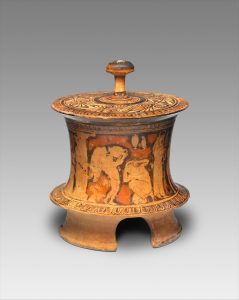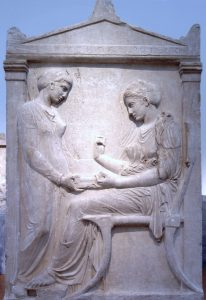20 A Vessel of Beauty: The Greek Pyxis and its Role in Women’s Lives
Laura Kenney
From jewelry boxes to makeup cases, humanity has always cherished small containers to store our personal items. Just as we store rings, cosmetics, and little trinkets, so did the ancient Greeks. Their version of a jewelry box or cosmetic case was called a pyxis. This item was more than a small container; it was a vessel of meaning, used in women’s daily life, reflecting social customs. But what exactly was the Greek pyxis and how did it reflect daily life and social customs?
What is the Greek Pyxis?

The Greek pyxis was a small, cylindrical container, typically with a removable lid, used to store small items such as jewelry, oils, and personal keepsakes. It was often related to daily life for grooming and rituals. Its name “pyxis” derives from the Greek word for box or container and would likely resemble the terracotta one in Fig. 20.1. However, ceramic was not the only material used: boxwood, bronze, silver, stone, and even ivory would have been used too.
Although the overall shape of the pyxis remained relatively consistent over time, several distinct types emerged, reflecting artistic preferences, as well as a need for easier transportation and improved functionality. Modern scholars classify these into four different sub-categories of type A, B, C, and D (as seen in Fig. 20.2). Type A, for example, had walls that curved in, a full circle base, and sometimes 3-4 small feet. Type B, on the other hand, was flatter and wider than type A, with much shorter walls. Type C was cylindrical, had vertical walls, and was small with a ring handle. Type D was also cylindrical but with a flat disc-like lid and was the most compact and simplest form of the four types.

Purpose and Evidence: Understanding Its Use

While visual and literary evidence on the pyxis is limited, we do have a lot of archaeological evidence and clues from some literary sources that help us make inferences about its use. In terms of cosmetics for example, we have a passage in Xenophon’s Economics, that discusses the use of “white lead”, believed to be psmithium, an ingredient used in make-up at the time ((Xen. Ec. 10. 1-13); see chapter 12 on cosmetics), stored in pyxides found in archaeological contexts . It was thus used as a powder box. Based on chemical analysis and interior glaze of excavated vessels, we can see that the pyxis could also hold liquids, such as oils.
Pyxides containing jewelry and trinkets have also been recovered from archaeological contexts, and through iconography on grave stelai, we can better establish their association. In Fig. 20.3, for example, two women are depicted: one, minimally adorned, stands to the left of the stele, presenting a pyxis filled with jewelry to the more elaborately dressed woman seated on the right. The presence of the pyxis and the contrast in their attire suggest that a servant is presenting the vessel, highlighting its association with elite women. Its depiction on a grave stele emphasizes its significance, indicating that the pyxis was not only essential to beauty and adornment in life but also symbolized the desire to reflect these cultural ideals in death.
Who Used It, and How Do We Know?
Due to its use and contents, the pyxis is frequently associated with women of elite status. The iconography on these vessels often depicts scenes of domestic life, like women weaving, marriage ceremonies, beauty rituals, and mythological themes that include Aphrodite and Erotes as well as Hera and Athena – all of which reflect ideals of femininity, including modesty, domesticity, and beauty. These scenes reinforce the societal expectation that women should embody chastity, devotion to the household, and preparation for marriage, mirroring the broader cultural values placed on elite women in Greek Society. In addition, the female figures in the depictions are usually young with idealized features, which indicates their use by younger women, particularly in the transition from girlhood to womanhood.
A passage in Aristophanes’ play, Assemblywomen, which describes an older woman using make-up, suggests that once acquired, the pyxis remained with a woman for life (Ar. Eccl. 877-880). While there is little evidence of enslaved people owning pyxides, they are often shown presenting the vessel to their enslaver, as previously seen in Fig. 20.3. Although they did not own pyxides, they were clearly involved in both their handling and maintenance.
The Pyxis and Its Role in Marriage and Coming-of-Age
Given the age in which a woman would acquire this vessel, what was kept in it, and its continued use throughout her life, it is believed to have been a marriage gift, acting as a vessel for storing items and any adornments necessary for the ceremony and the transition into marital life. Its role in these contexts is evident by the iconography found on them. For example, women often underwent pre-marriage grooming processes that would have involved cosmetic items like powder, oils, mirrors, and jewelry to prepare themselves for marriage, all of which are seen in Fig. 20.4, where the bride Iphigeneia is getting ready. These recurring scenes on pyxides reinforce their importance to female identity and reflect the shift in her societal role.
The pyxis was not only connected to marriage but also the broader coming-of-age process, marking milestones like puberty, marriage preparations, and the acquisition of personal items symbolizing maturity. The frequent depictions of wedding ceremonies and brides such as Iphigeneia on pyxides highlight the importance of this life transition.
A Woman’s Transition from Girlhood to Womanhood
As a bridal gift and memento, the pyxis would be gifted to the bride by her future groom or by her parents to remind her of her wedding day. It signified her reaching puberty and the transition from childhood to adolescence. This idea is also reflected through marriage iconography with doorways or thresholds as seen in Fig. 20.4, symbolizing the passage into womanhood. The frequent depiction of brides in doorways and preparing for marriage with elaborate hairstyles, jewelry, and cosmetics as seen in this image, reinforces the connection between adornment and a woman’s social role.

These images highlight the importance of beauty rituals and domestic training, both essential elements of a woman’s preparation for marriage, which she would have been taught at home. Together, these scenes illustrate the pyxis’ role in shaping a woman’s journey into adulthood while also offering insight into Athenian ideals of womanhood. The imagery on gifted pyxides reflects not only how men perceived the ideal woman, but also how they expected women to present themselves. Furthermore, it demonstrates that a woman’s appearance was directly tied to her domestic role, signalling her readiness for marriage, motherhood, and her duties within the household.
It is apparent through its frequent association with grave burials and iconography that this vessel was important within a woman’s life, especially during her transitional age to adulthood. Even women who did not reach marriage as a result of unforeseen circumstances received a pyxis within their graves to symbolize their lost potential. Therefore, the Greek pyxis is more than just a functional container; it is an artifact that speaks to the lives of women in ancient Greece: their beauty, adornment, ideals of femininity, as well as marriage ritual. It thus reflected their identity in society. Its relation to marriage rites and marriage themes in its decoration indicates the occasion as one that Athenians deemed as one of the most important events in a woman’s life.
Bibliography and Further Reading
Blundell, S., and N. S. Rabinowitz. 2008. “Women’s Bonds, Women’s Pots: Adornment Scenes in Attic Vase-Painting.” Phoenix 62.1–2: 115–44.
Carrillo, R. H. 2006. “Putting the Pieces Together: The Mystery Surrounding an Attic Pyxis from the University of Mississippi Robinson Collection.” Honors Theses. Oxford: Sally McDonnell Barksdale Honors College Press, 28–37.
Lee, M. M. 2015. Body, Dress, and Identity in Ancient Greece. Cambridge: Cambridge University Press.
Mangieri, A. F. 2010. “Legendary Women and Greek Womanhood: The Heroines Pyxis in the British Museum.” American Journal of Archaeology 114.3: 429–45.
Roberts, R. S. 1978. The Attic Pyxis. Chicago: Ares Publishers.

